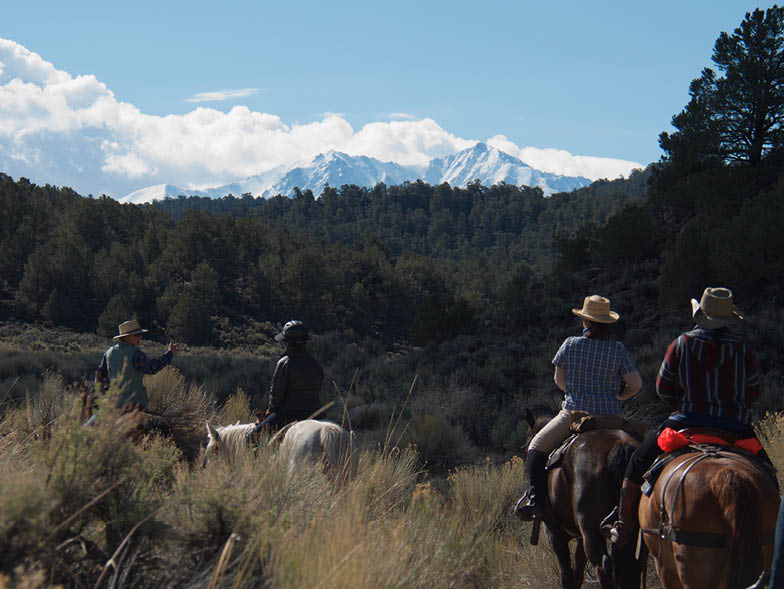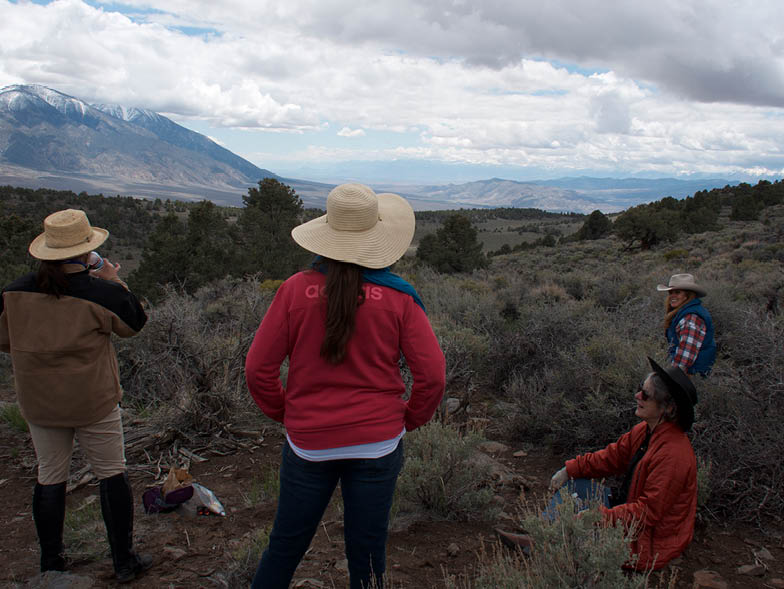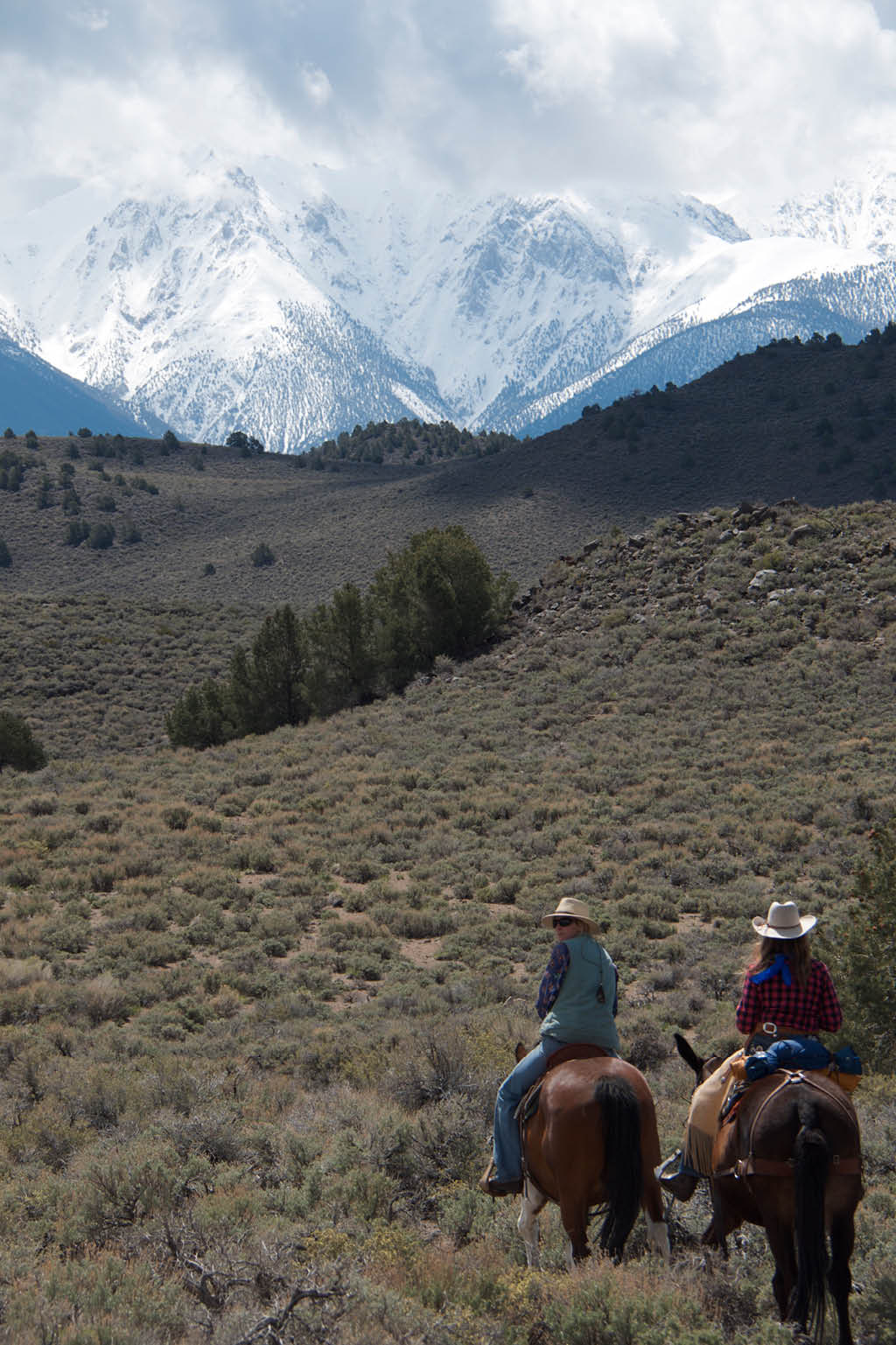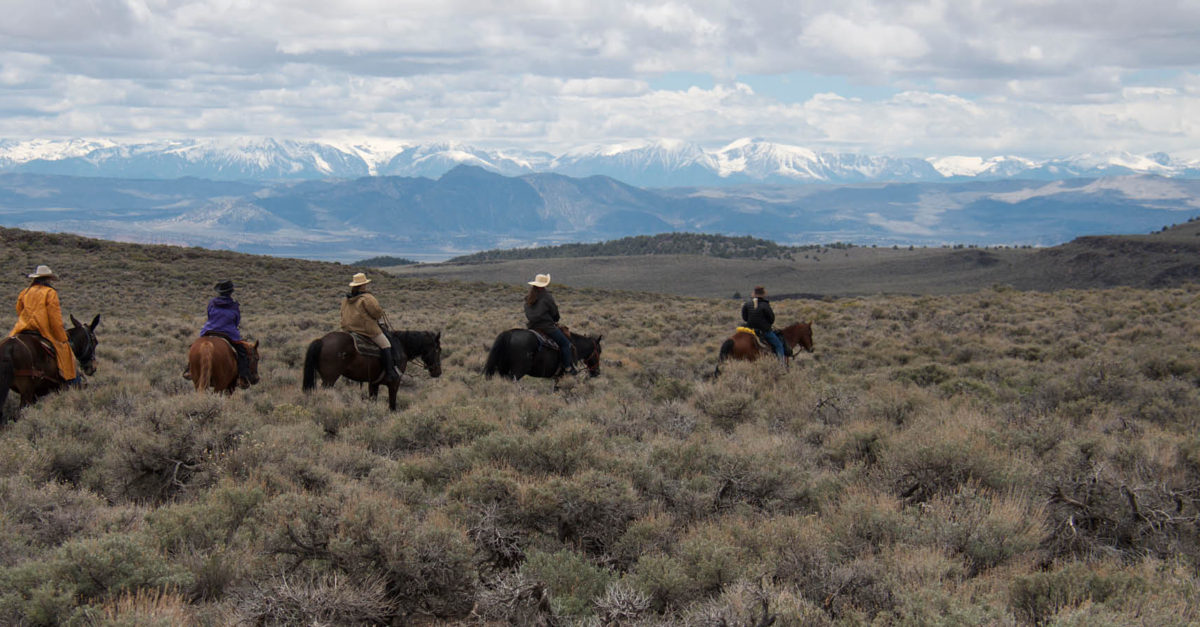In Search of Wild Mustangs
Getting away from it all and getting back to nature can be an exhilarating, rejuvenating adventure. And nothing delivers this experience quite as well as traveling to wide-open spaces to witness animals in their natural habitat, as writer Mark Bedor discovered during his quest for wild mustangs in the mountains of eastern California.
It is a rare and thrilling sight in the American West. After spending hours on horseback searching for the wild mustangs that live in the high desert along the California-Nevada border, we’ve hit the jackpot. Zooming in on the dramatic scene with cameras and binoculars, our group of six riders watches in rapt attention as two bands of wild horses do battle.
It’s not really violent. But it is fascinating to watch this confrontation play out. The black stallion leading a band of five mustangs charges into a smaller group of four horses attempting to join them.

The stallion follows his charge by aggressively pawing the dirt, turning away, and then quickly pivoting back, rearing, and charging again. The four mares accompanying the stallion join in the attack, charging the small band to push it away. The back and forth goes on for some time. Finally, the rejected group apparently gets the message and gives up, and the two bands of horses drift off in opposite directions. But it’s been quite a show. “This was very unusual,” says guide and wrangler Ivana Crone. “I learn something here every day. There’s a lot of behavior you don’t read in any books. The wild horses teach you.”
Ivana could well write a book on her experiences with mustangs. The native of the former country of Czechoslovakia has been leading horseback expeditions to view the Montgomery Pass wild horse herd for seventeen years. It’s a labor of love. “I always feel this certain connection,” she says of the mustangs. “It’s hard to explain unless you feel it. It’s something you have inside.”
This outside adventure takes place in the shadow of the towering, snowcapped peaks of the White Mountains, about fifty miles north of Bishop, California. This unspoiled wilderness of sage, piñon pine, meadow, and mountain in the Inyo National Forest is as beautiful as anywhere in the West. But with its freezing winters and scorching summers, few people ever set foot where we’ve come, a remote area of the Inyo known as the Pizona section. And none of us would be here at all if not for Rock Creek Pack Station.
Rock Creek is among the few Eastern Sierra outfitters to offer guided horseback treks every spring to see the mustangs that roam here. The expeditions give adventurers access to this high desert before the summer heat sets in and the snow melts in the high country of the Sierra Nevada Mountains, just to the west, where the outfitters spend the summer.

But even if you never see a wild horse, this four-day trip is worth it just to be here. “Doesn’t get any more wide open!” smiles Ivana, as we break for a sack lunch, pulled from a saddlebag after a long morning’s ride.
The country we’re riding through is spectacular, vast, unspoiled, and empty. From the ridgeline where we stand, we can see perhaps fifty miles away. Coming from crowded Los Angeles, it’s wonderful to know such places still exist. A lonely windmill in an immense high country meadow and an old stagecoach trail we follow are among the few signs of humanity.
Our adventure began at a trailhead corral at the end of a dirt road, near the brown and weathered wooden remains of an old stagecoach station. There we’d met our fellow travelers, the horses or mules we’d ride in the days to come, and our expert guides. The wranglers showed us the way, handling the saddling and other heavy lifting and preparing those hot breakfasts and hearty dinners that always taste so good outdoors.
After swinging into the saddle the first day, we didn’t have to wait long to see mustangs. Just after leaving the trailhead for the half-day trek to our remote base camp, we rode to a huge, soggy meadow to visit a herd of perhaps sixty mustangs—a Montgomery Pass subgroup known as the River Springs herd. It included a number of new foals. Those very young horses were a special treat to see, staying close to mom and still nursing. We also got a close-up look at the behavior of wild stallions. “See how that stallion is rounding up his mares?” Ivana asked us, as she pointed to a palomino stud. “He puts his head down, arches his neck, and threatens to bite them on the feet . . . so he rounds them up where he wants them to be.”
Our guide told us the entire herd actually follows the lead of an alpha mare. But within the herd, stallions battle each other for dominance, with the prize for the winner being the chance to breed with a closely guarded harem of mares. The losers hang out together in small groups of so-called “bachelor stallions.” Either way, many of the stallions bear the noticeable bite marks and other scars from their violent clashes.

This trip to wild horse country is a roughing-it adventure, including sleeping on the ground in tents. But the camp crew does its best to keep things comfortable, even rigging up a hot outdoor shower. They can’t do much about the rain, which we saw plenty of, but the timing of those frequent storms was pretty close to perfect. We had downpours at night as we slept, and the rain came down hard while we ate dinner. But a big canopy kept us out of the weather, and a warm fire was always close at hand.
Outdoor cooking in this wilderness has its challenges. “Most of the time it’s the weather and the sand,” laughed our ace cook, Gene. “We got a lot of weather and not too much sand. But if it dries out and the wind comes up, I stay busy trying to keep the dust down.” But there would be no complaining from our hardy group of guests. “I’m loving it!” smiled Andi Duncan, an adventurous sixtysomething woman. “I had a great day riding through the canyon. I’m not great on sleeping outdoors,” she admitted. “But it’s the price you pay for such a wonderful time.” Likewise, Nathan Jagger, here with his horse-loving wife Suzanne, mused, “Understanding horses in their wild environment is very unique. How they survive, what they do . . . We’ve seen all that on this trip. It’s a very unique experience. I like it. I would come do it again in a heartbeat.”
Even on a day we didn’t see wild horses, evidence of mustangs was everywhere we went. ”We actually do see the horses in a different form,” Ivana told us. “We see where the stallions mark their territory. And we can see where they were and what they were doing. We can just read their lives by their hoofprints.”

We also saw the relics of the “mustangers” who were once free to gather whatever wild horses they could capture, before the animals were protected by a 1971 Act of Congress. Riding through a canyon, we could still see the remains of the trap fence used to corral the horses and the old gate that shut them in.
Then there are the truly mystical petroglyphs left behind by the people who lived here long ago, such as drawings of human figures, hands, and animals carved in the rock. Nearby, Ivana showed us a pair of long poles used by Paiute people to gather pinecone nuts and told us they may date back to the 1800s. Today, they were leaned up against a huge tree, as if their owners would soon be back. “How do we know this is not just a regular piece of wood?” Ivana asked rhetorically. “This is willow. And it had to be carted here at least five miles. That’s why we know these are actually real tools.”
Along the trail, we came across the scattered bones and sometimes the complete skeletons of the mustangs that had lived and died here. Mountain lions have largely kept the horse population in check, and this natural balance means the US Bureau of Land Management hasn’t had to do any mustang roundups and removals here to prevent overgrazing. According to Ivana, this makes the Montgomery Pass herd one of the few truly wild horse herds in the country.
Mustangs have long been a romantic symbol of the beautiful, unspoiled Wild West. And this land where they still roam free probably looks much like it did when the first wild horses laid tracks here hundreds of years ago. The mustangs don’t seem to mind visitors who are careful to respect their boundaries. And Rock Creek makes their fascinating world very accessible. The outfitter’s well-trained horses and mules are easy even for beginners to ride, the crew takes good care of everyone, and there’s always room for one more—not to mention the chance to disconnect from all that noise, stress, and aggravation back in the modern world. It might require stepping out of your comfort zone, but you’ll be glad you came. As one wrangler put it, “Life is short. Knowing that, you have to come one time. You have to come and see it.”
For more info, visit rockcreekpackstation.com.






















